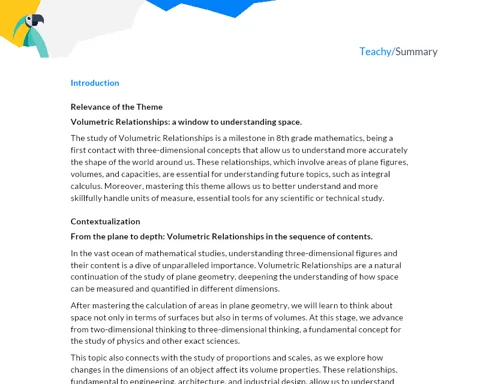Introduction
Relevance of the Theme
Unit Systems are the structural basis for the quantification and measurement of everything around us. These structures are used not only in mathematics but in all sciences, technology, and even in our daily lives. A solid understanding of these structures allows for precise communication of measurements, enabling scientists, engineers, doctors, and even cooks to ensure reliable and safe results in their endeavors.
Contextualization
Unit Systems are the 'language of mathematics applied to reality', where the abstract connects with the concrete. By combining fundamental quantities such as length, mass, and time, we can describe and quantify many other complex quantities. At this stage of the curriculum, students have already been introduced to basic mathematics and are ready to explore these more advanced concepts, which will provide the foundation for future studies in physics, chemistry, engineering, economics, and many other areas.
Theoretical Development
Components
-
Units of Measurement: These are fixed standards we use to quantify a quantity. We have units of measurement for length (meter, centimeter, etc.), mass (gram, kilogram, etc.), time (second, minute, hour, etc.), and many other quantities.
-
Unit Systems: These are organized structures consisting of a set of interrelated units of measurement. There are several unit systems in current use, with the International System of Units (SI) being the most common. Other systems include the imperial system, the old metric system, and the cgs system (centimeter-gram-second).
-
Unit Conversion: It is the process of changing a quantity expressed in one unit of measurement to an equivalent expression in another unit. Unit conversion is a crucial skill for effective communication of measurements.
Key Terms
-
Meter (m): Basic unit of length in the SI. 1 meter is the distance traveled by light in a vacuum during an interval of 1/299,792,458 of a second.
-
Kilogram (kg): Basic unit of mass in the SI. 1 kilogram is equal to the mass of the international prototype of the kilogram, a platinum-iridium cylinder kept at the International Bureau of Weights and Measures in France.
-
Second (s): Basic unit of time in the SI. 1 second is the duration of 9,192,631,770 periods of the radiation corresponding to the transition between the two hyperfine levels of the ground state of the cesium-133 atom.
Examples and Cases
-
Converting meters to centimeters: To convert 5 meters to centimeters, we multiply 5 by 100, as 1 meter is equivalent to 100 centimeters. Therefore, 5 meters is equal to 500 centimeters.
-
Converting kilograms to grams: To convert 2 kilograms to grams, we multiply 2 by 1000, as 1 kilogram is equivalent to 1000 grams. Therefore, 2 kilograms is equal to 2000 grams.
-
Converting hours to minutes: To convert 3 hours to minutes, we multiply 3 by 60, as 1 hour is equivalent to 60 minutes. Therefore, 3 hours is equal to 180 minutes.
These examples illustrate the direct application of unit systems and unit conversion concepts, essential components of real-world mathematics.
Detailed Summary
Key Points:
-
Significance of Unit Systems: Unit systems are the basic structure of quantification and measurement. They allow for a precise and universally understood description of physical quantities. The most widely used unit system is the SI (International System of Units), which is a decimal system.
-
Composition of Unit Systems: Unit systems are built based on fundamental units, such as the meter (for length), the kilogram (for mass), and the second (for time). These fundamental units form the foundation upon which derived units are built, such as velocity (meter per second), density (kilogram per cubic meter), and many others.
-
Understanding and Applying Unit Conversions: The ability to convert units from one quantity to another is fundamental to applied mathematics. Unit conversion involves the use of conversion factors, which are fixed relationships between different units of the same quantity. A common example is the conversion of meters to centimeters, which uses the conversion factor 100 (1 meter is equal to 100 centimeters).
Conclusions:
-
Practical Importance of Unit Systems: Unit systems have a practical and tangible impact in various areas of science, technology, and everyday life. They allow for the standardization of measurement, ensuring that all measurements are comparable and universally understood.
-
Need for a Solid Understanding in Unit Conversions: The ability to convert units is a powerful tool that allows for comparing and describing quantities in terms that are more meaningful for a given situation. For example, a car's speed can be expressed in meters per second (a common unit of measure in physics) or in kilometers per hour (a unit of measure more familiar to drivers).
Exercises:
-
Length Conversions: Convert 2 meters to centimeters, 1 kilometer to meters, and 10 centimeters to millimeters.
-
Mass Conversions: Convert 500 grams to kilograms, 0.8 tons to kilograms, and 0.002 kilograms to grams.
-
Time Conversions: Convert 4 hours to minutes, 30 minutes to seconds, and 2 days to hours.



